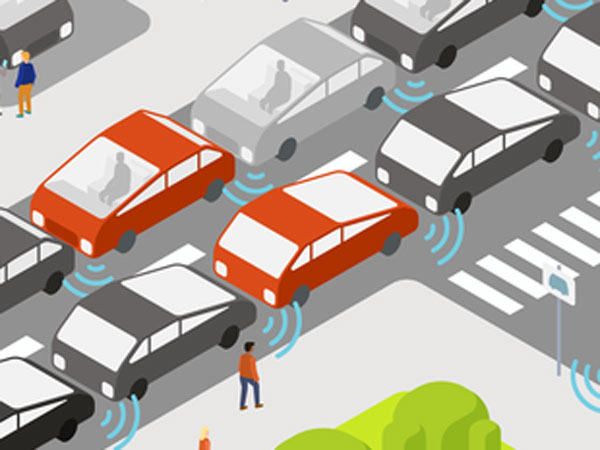If not regulatory factors are established the potential for chaos in urban areas are likely.
Automated vehicles have great potential in improving individual mobility and traffic safety, as well as reducing environmental burdens. However, automated vehicles are also expected to present various challenges when it comes to important policy goals, such as zero-growth for car use in urban regions, reduced urban sprawl and improved public health.
A new TØI study emphasizes automated vehicles’ impact on personal mobility. This is the first study of automated vehicles in a Norwegian context.

Traffic chaos can be the result in urban areas in the future if the use of automated vehicles is not regulated. / Illustration: Audun Gjerdi.
Five scenarios for automated vehicles
Recently, automated vehicles have been tested in designated Norwegian settings. Preliminary results illustrate clearly the need for active preparation, as opposed to reactively waiting for further technological progress. Dedicated policies and organizational facilitation are necessary means to successfully bring the process forward.
A number of criteria must be addressed though:
Will the automated vehicles be in private, shared or public hands – and in private or rideshared trips? What will be the consequences of the various situations?
Based on these criteria five scenarios for automated vehicles have been selected:
- Private automated cars for all
- Curbing urban congestion
- Shared automated car fleets
- Automated vehicles for ridesharing
- Automated vehicles in scheduled public transport.
A further introduction of automated vehicles in the Norwegian context will probably draw primarily on the various sharing models, organized by a mixture of public or private transport network companies.
The preliminary findings to societal consequences in a Norwegian context conclude that shared models will be the most probable, either by shared automated car fleet for private car use, or shared rides in minibuses (micro-transport) run by public or private companies. Micro-transport companies only, with already established legal permissions for transport services, are legible to execute pilots with self-driving vehicles in Norway.
Private trips in car-shared vehicles not suitable
National and regional policy goals of reduced urban car use make the policies and measures from the curbed urban congestion scenario necessary. At the same time, an intensified public transport scenario with automated trains and buses is highly probable.
Only the latter will require public investments or financial support. On-demand automated vehicles in car-sharing schemes will probably draw on today’s car-sharing providers. These vehicles will resemble driverless taxis. Even if there is a limited use of private taxis today, the situation will be quite different when eliminating the cost of the driver. An excessive use might easily be foreseen.
Furthermore, different types of car-sharing scenarios are well-suited both in urban, suburban, and rural districts. Private trips in car-shared vehicles are, however, not very suitable for routinized travels (to work, for regular transport services for special groups, e.g.). This is a field where micro-transport, like small automated minibuses, will be relevant. These are schemes that might be run by public or private (commercial or non-profit) transport companies.
The expected timing of the first introduction and further implementation of automated vehicles vary considerably. Some studies suggest automated vehicles on motorways early in the 2020s, and in urban areas a few years later. Other scenarios suggest every 10th vehicle to be conditionally automated in 2030, and 60 percent of the fleet fully automated in 2060.
In general, the potential for lower costs, reduced environmental burden and improved traffic safety substantiates that automated vehicles may change our transport system fundamentally in the decades to come. And – based on previous early transport policies and early initiatives in the Norwegian context (i.e. from the public transport companies Ruter, Brakar and Kolumbus), new projects will take place in the Oslo, Buskerud and Stavanger region.
Report:
Societal consequences of automated vehicles – Norwegian scenarios.
 Contact:
Contact:
Vibeke Nenseth
vne@toi.no
Institute of Transport Economics (TØI), Norway






Follow us: